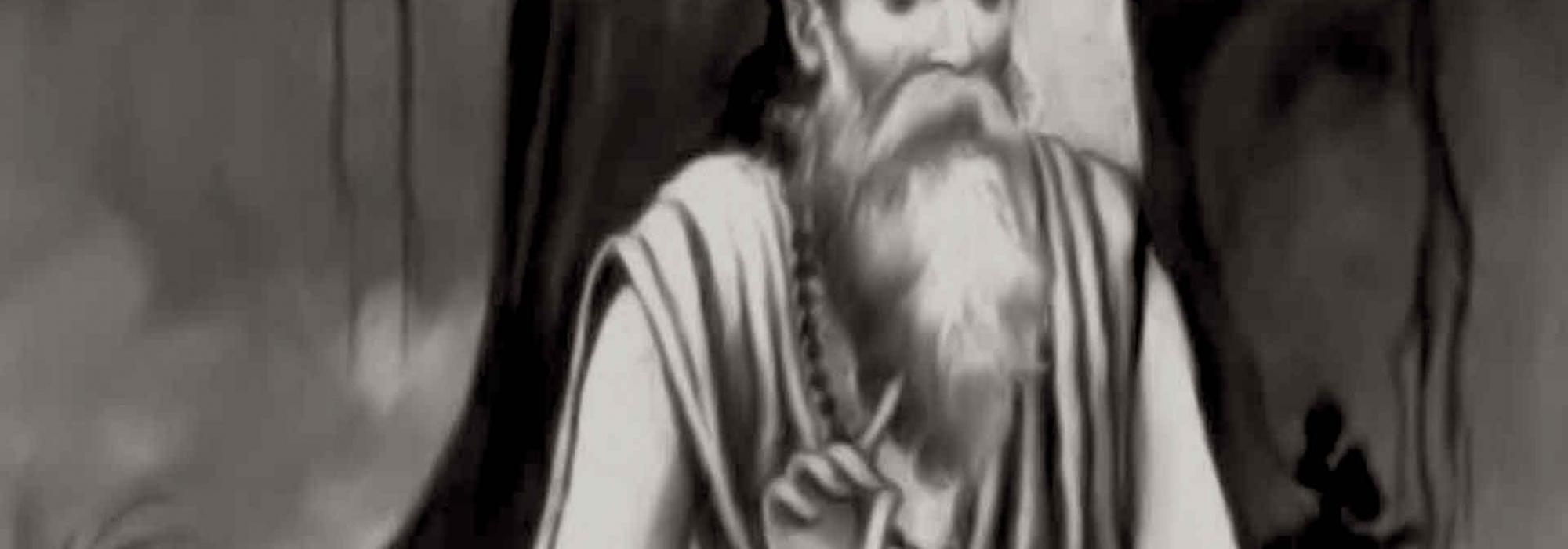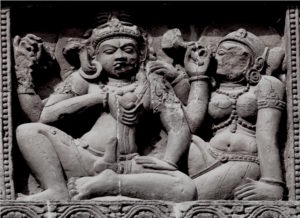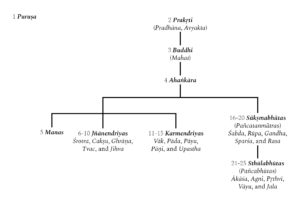Philosophy in the Mahābhārata : Sāṅkhya
A few things must be mentioned before entering into this discussion. As stated earlier, the extant Mahābhārata was composed in a span of about thousand years and different parts were added and modified at different points in time, thus making it extremely difficult to summarize the view of the epic on a given topic. Such an attempt might even lead to error; it is for this reason that most scholars felt the need for a critical edition. However, such an edition is still unavailable [c. 1950]; Sukthankar’s edition has been prepared by referring to the most ancient manuscripts; it is however incomplete [The complete critical edition under the supervision of V S Sukthankar was published by the Bhandarkar Oriental Research Institute in 1966.] If one were to delineate the philosophy and associated dharma in the epic, it might not convince everyone. Having omitted those sections that I felt were obvious interpolations and later additions, I have summarized below the philosophy that will help the reader of the Vacana-bhārata. Those who want more information may refer to the original Sanskrit text and scholarly articles.
In the epic, the only darśanas [schools of Indian philosophy] that are explicitly stated at several places are Sāṅkhya and Yoga. However, during the time of the composition of the epic, these were not yet developed to the extent that they might be classified under the heading of darśanas. Dr. Bhandarkar describes their essence thus:
“The speculative philosophy, therefore, that existed about the time of Svetasvatara Upanishad and the Bhagavadgita was known by the name of Sāmkhya, and out of it grew the non-theistic system of later times. The Yoga, the philosophy of action, too, did prevail, but it culminated as indicated before into a concentration of mind, the ordinary operation being suspended on the Brahman, Akṣara or the Supreme Soul.”– Vaishnavism, Saivism, etc. pp. 38-39.
[Translator's Note: Works like Sāṅkhya-kārikā and Yoga-sūtra that propound the Sāṅkhya and Yoga darśanas came after the composition of the epic.]
The Brāhmaṇas, Āraṇyakas, and Upaniṣads that form the backbone of Mīmāṃsā and Vedānta were available before the composition of the Mahābhārata, but they (i.e. Mīmāṃsā and Vedānta) hadn’t yet taken the shape of full-fledged darśanas. As for the Nyāya and Vaiśeṣika schools, they had not yet come into existence. Therefore, I wish to elaborate a little bit about these two darśanas [i.e. Sāṅkhya and Yoga.] To bring clarity to my explanations, I have taken the help of the Upaniṣads and others later texts including the Sāṅkhyakārikā.[1]
[Translator's Note: Though Vedāntic concepts were very much in vogue, the Vedānta-sūtra, i.e., Brahma-sūtras were not yet composed.]
According to Sāṅkhya, the world is not the creation of a God; it is merely a pariṇāma (transformation, metamorphosis) of prakṛti that is all-pervading. Prakṛti is made of the triguṇa – sattva, rajas, and tamas (these three are the basic traits/ qualities). When the three guṇas are at equilibrium, prakṛti remains inert; it is inactive. By nature, prakṛti is inert. The puruṣa, who is ‘prakāśa-svarūpī’ i.e., the illuminator by nature, invigorates prakṛti. Both puruṣa and prakṛti are satya (real, true) and anādi (beginningless).
Due to the ‘adṛṣṭa’ (inexplicable force) or influence of puruṣa, the equilibrium of the guṇas is disturbed and as a result prakṛti begins to transform itself, thus resulting in creation of the world. Neither puruṣa nor prakṛti can create the world independent of the other. It is like the camaraderie between the lame and the blind (‘andha-paṅgu-nyāya’). The lame cannot move without external help and neither can the blind. But if they cooperate with each other, then they can lead their lives; creation can come into being.
In this ‘creation,’ there is nothing new that comes into existence. Everything was pre-existent (just like the limbs of a tortoise that always exist come out of its shell). The Sāṅkhyatattvakaumudī states “यथा कूर्मः स्वावयवेभ्यः सङ्कोचविकासिभ्योः न भिन्नः, एवं घटमकुटादयोऽपि मृत्सुवर्णादिभ्योः न भिन्नाः” (Whether the limbs of a tortoise are contracted or expanded, the tortoise remains the same. Similarly, there is no difference between a pot and mud or a crown and gold.) The same set of objects that existed are constantly transformed into newer ones; it is the seed that finds expression in a plant and it is the same plant that grows into a tree; it is the tree that produces flowers and fruits; thus, Sāṅkhya proposes pariṇāma-vāda (also known as satkārya-vāda), the theory of transformation.
The properties of sattva, rajas, and tamas are different; their nature is also different from one another – brilliance, activity, and lethargy; they result in sukha (happiness), duḥkha (sorrow), and moha (attachment) (Sāṅkhyakārikā 13). But they cooperate and work with each other in the process of creation, just like fire, wick, and oil work together to light a lamp. They do not exist apart from each other; it is not possible for them to exist in a vacuum. The three, in the right combination, constitute ‘prakṛti.’ However, since they are largely different from each other, different objects are formed depending on the proportion of each guṇa. The ‘creation’ thus comes into being. Since creation is a transformation of prakṛti, which is made up of these three guṇas, every object in the world has these guṇas in some proportion. In an object, one guṇa might be predominant while another might be insignificant.
Prakṛti is one but the puruṣas are many. The changes that take place in prakṛti and the joys and sorrows thus caused are experienced by puruṣas. If rajas and tamas are subdued with sattva being dominant, it gives rise to ‘viveka’ (wisdom, power of discernment), and the puruṣa gets to know his true Nature (svasvarūpajñāna). [Saṃ + khyā = closely examine, introspect, contemplate on the true nature of things. The word Sāṅkhya can also mean ‘number’ or ‘numeric’ as the principles of creation are well-calculated and documented in this darśana.] Once the puruṣa realizes his true nature, he gets separated from prakṛti; that is kaivalya or mokṣa (liberation, release). The entire process of creation executed by prakṛti is meant to kindle this viveka in the puruṣa through which he gets jñāna and mokṣa. [Sāṅkhyakārikā 21 says “पुरुषस्य दर्शनार्थं कैवल्यार्थं तथा प्रधानस्य। पङ्ग्वन्धवदुभयोरपि संयोगस्तत्कृत: सर्ग:॥” (The purpose of creation by prakṛti is the kaivalya of the puruṣa – it is similar to the lame and the blind helping each other.)] Once the purpose of prakṛti is accomplished, i.e. once all the puruṣas are liberated, prakṛti retires just like a dancer leaves the stage after her performance; this causes pralaya (dissolution) (Sāṅkhyakārikā 59). Until this wisdom dawns in the puruṣa, he transmigrates in his liṅga-śarīra (subtle body) from one birth to another, carrying the baggage of saṃsāra (material world).
The process by which prakṛti creates the world is shown as follows:
In summary, the Sāṅkhya consists of twenty-four tattvas (principles, elements) and twenty-five, if the puruṣa is counted.
Sāṅkhya is an ancient darśana; one could even say that it is older than all other darśanas. It is hard to say if it has taken inspiration from the Upaniṣads or developed independent of them.
The Kaṭhopaniṣad (3.10-11, 6.7-8) also speaks of few of the tattvas – the five senses, mind, mahat (intellect), avyakta (prakṛti), and puruṣa:
इन्द्रियेभ्यः परा ह्यर्था अर्थेभ्यश्च परं मनः ।
मनसस्तु परा बुद्धिर्बुद्धेरात्मा महान्परः ॥१० ॥
महतः परमव्यक्तमव्यक्तात्पुरुषः परः ।
पुरुषान्न परं किञ्चित्सा काष्ठा सा परा गतिः ॥११ ॥
(Kaṭhopaniṣad 3.10-11)
इन्द्रियेभ्यः परं मनो मनसः सत्त्वमुत्तमम् ।
सत्वादधि महानात्मा महतोऽव्यक्तमुत्तमम् ॥ ७ ॥
अव्यक्तात्तु परः पुरुषो व्यापकोऽलिङ्ग एव च।
यं ज्ञात्वा मुच्यते जन्तुरमृतत्वं च गच्छति॥ ८ ॥
(Kaṭhopaniṣad 6.7-8)
The four verses, in summary state:
The objects of the senses are superior to the sense-organs and the mind is superior to these objects. The mind is superior to the sense organs; the intellect is superior to the mind; mahat is superior to the intellect and avyaktam is superior to mahat. But, the Purusa is superior to mahat, is all pervasive and without worldly attributes. Realizing him, one attains liberation and immortality
The Śvetāśvataropaniṣad (4.5) says, “अजामेकां लोहित-शुक्ल-कृष्णां बह्वी प्रजाः सृजमानां सरूपां...” This verse describes the prakṛti, which is composed of the three guṇas. However, there are other interpretations for this line.
Of late [c. 1950], people claim that Yoga originated from the times of Mohenjo-Daro. It is likely that Yoga existed alongside with Sāṅkhya. There is a difference in opinion about the antiquity of Mohenjo-Daro, whether it is from the pre- or post-Vedic period.
Not just in the Upaniṣads, but even in the Mahābhārata, Sāṅkhya is described at several places. However, the descriptions of the philosophy within the epic differ slightly from place to place. It is hard to say what the reason for these differences and repetitions are. At one place, the twenty-five tattvas are mentioned along with another (twenty-sixth), i.e. īśvara, which is said to be above them all. According to this passage, once the puruṣa gains wisdom (viveka-jñāna) he proceeds to reach the īśvara, the highest tattva. In the Mahābhārata, at several instances, īśvara is given great importance. He has been hailed variously as dhāta, vidhāta, etc. In Yoga, what is called puruṣa-viśeṣa is nothing but īśvara. Here, īśvara does not refer to the deity Śiva. It merely refers to a leader, a ruler, or a Supreme being. There is no place for a personal god here.
The verbal manifestation of īśvara is the oṃkāra, also call praṇava (Yoga-sūtra 1.27). Swami Vivekananda says, “Om (Aum) (sic) is such a sound, the basis of all sounds. The first letter, A (sic), is the root sound, the key, pronounced without touching any part of the tongue or palate; M represents the last sound in the series, being produced by the closed lips, and the U rolls from the very root to the end of the sounding board of the mouth. Thus, Om represents the whole phenomena of sound-producing. As such, it must be the natural symbol, the matrix of all the various sounds. It denotes the whole range and possibility of all the words that can be made.”
Moreover, Sāṅkhya, unlike Vedānta, does not derive from the teachings of the Upaniṣads; therefore, there is no rule that only those initiated into the Vedas can study Sāṅkhya-Yoga.
Just as a tortoise withdraws its head and limb into its shell, thus taking on its fundamental form of being, so does the manifest universe withdraw into prakṛti giving it its fundamental state. This state makes it conducive and easy for the puruṣa to experience kevala-stithi (absolute existence, liberation). The path to gain such experience is Yoga.
[1] Those interested in learning more about the Sāṅkhya and Yoga darśanas may refer to the following works:
- S Radhakrishnan. Indian Philosophy. Vol. II, pp. 248-374.
- M Hiriyanna. Outlines of Indian Philosophy, pp. 267-97.
- M Hiriyanna. The Essentials of Indian Philosophy, pp. 106-28.
- A Berriedale Keith. Saṁkhya System.
- Ganganatha Jha. Tattwakaumudi (Saṁkhya).
- Swami Vivekananda. Rajayōga.
- E H Johnston. Early Saṁkhya: An Essay on its Historical Development According to the Texts
- Swami Prabhavananda. Spiritual Heritage of India
- Chandradhar Sharma. A Critical Survey of Indian Philosophy



















































